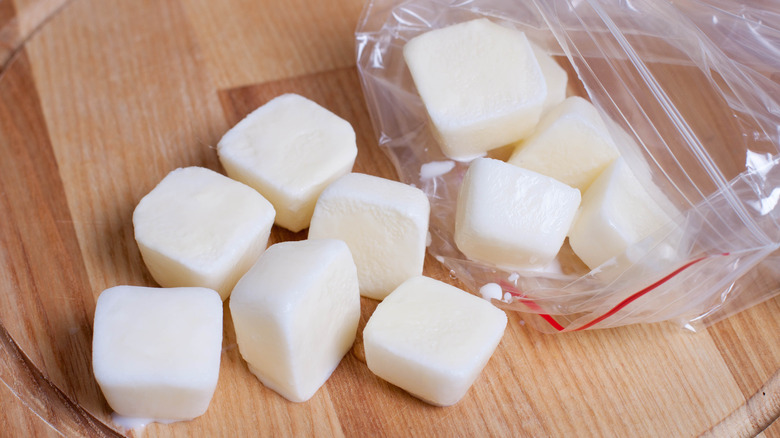You Can Freeze Milk, But There's A Catch
There's nothing more disappointing than opening your refrigerator first thing in the morning and realizing that you're out of milk — meaning no coffee, cereal, or oatmeal bowl to get the day started! But, what if you had a stash of frozen milk tucked away for this exact scenario? After all, milk can last for anywhere between one to six months in the freezer, which is more than one can expect from its non-frozen counterparts.
However, there's one storage mistake you need to stop making before you freeze dairy. Milk expands as it freezes, which can cause cracks and shatter glass and cardboard containers. This is why you'll want to transfer the liquid to another container first, and make sure to leave at least an inch of empty space for it to expand.
Canning jars, plastic containers, and ziplock bags are all excellent options; you could also use ice cube trays to make single-serve portions of frozen milk that are more convenient to thaw and use. It's also possible to freeze the milk in the container that it came in if you're in an absolute pinch, especially if it's a plastic carton that's less susceptible to breaking. Be extra careful to leave plenty of room for the milk to expand when doing so though, and seal the container tightly — milk can easily absorb the smell of other foods sitting next to it.
How to thaw frozen milk
When you're ready to use your frozen milk, transfer it to the refrigerator to let it thaw. This can take anywhere from 24 to 36 hours, but it's important not to rush the process. Frozen milk should never be heated directly or left at room temperature to hasten thawing, as exposure to temperatures higher than 39.2 degrees Fahrenheit can cause bacteria to multiply. Instead, place the container in cold (not hot) water to speed things up, or add the milk directly to the recipe if you're planning to use it for a cooking application like soups and stews.
Once thawed, the milk should be consumed as quickly as possible, ideally within three to four days at the very latest. However, don't be alarmed if the milk has lost its luscious consistency and looks grainy when defrosted. This usually happens because the fat present in the milk separates when frozen. All you need to do is give it a shake or blend it to bring back that velvety texture. Rather than judging it by its consistency, observe the color of the milk and what it smells like: Spoiled milk will have a yellow tint and will emit a distinct sour and curdled odor — which are the same signs you'll find in soy milk that has gone bad too. That's when it's time to toss your frozen milk out.
Not all milks freeze well
While milk can be frozen, thawed, and consumed safely for months on end, not all milks are equally suited for the job. For instance, cow and goat milk are some of the best options for freezing. You might notice a slightly grainy texture from fat separation with these two, but it's nothing a quick shake can't fix. Even with these dairy-based choices, low-fat or skimmed varieties will freeze comparatively better since they have less fat that can become separated.
On the flip side, plant-based milks made from almonds, oats, soy, and flaxseeds will get much grainier than dairy-based milks. If you're freezing these, consider using them in cooked or blended recipes rather than drinking them plain. The same goes for coconut milk: The cream will separate from the water, leaving a grainy liquid when thawed. You could fix the texture of separated coconut milk, but it's best to use it in recipes where its gritty texture won't be noticed.
However, if you have a shelf-stable pack of milk, you might not need to freeze it at all. Shelf-stable milks can last for months at room temperature and only have to be refrigerated or frozen once they are opened.



